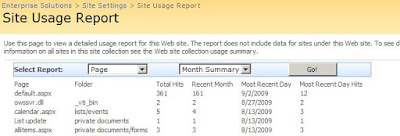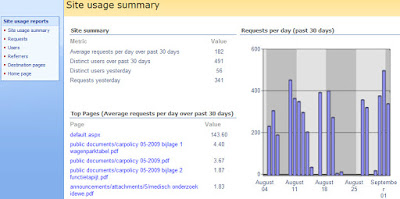Today my Windows XP showed me a very unwelcome BSOD… booting in safe mode, last known configuration, nothing helped. Unfortunately I still had some files on the machine which I definitely needed to recover – Hirens Boot CD to the rescue – amazing tool… definitely a lifesaver.
Wednesday, September 23, 2009
Sunday, September 13, 2009
Quick Tip – Excel Advanced Filters
Amazing the things you can do with Excel – check out -http://www.contextures.com/xladvfilter01.html
Wednesday, September 09, 2009
Dynamics CRM and SharePoint – birds of a feather?
Microsoft Dynamics CRM is increasingly becoming an application platform for decidedly non-marketing uses. In this way it is moving away from it’s core platform functionality – Customer Relationship Management. Microsoft likes to talk about xRM applications (check out Developing ISV applications using Microsoft Dynamics CRM ) which are basically line of business (LOB) applications that use the Dynamics CRM database, extend the basic CRM web interface and add in extra logic using CRM workflows.
While Dynamics CRM and Microsoft SharePoint are definitely complimentary platforms, this evolution allows you to probably build solutions on top of both SharePoint and MS CRM. Think about the following scenario’s:
- Project management framework
- Service desk and call follow up
- Sales dashboards
- Bid management – RFP process automation
- Recruitment process automation
- Citizen Service Platform (e-Government)
You can probably start from both SharePoint and CRM as a foundation and from there on build in the required functionality for your solution. Interesting choices … but who is making this choice?
From a development perspective you will also see some similarities.
| Dynamics CRM | SharePoint | |
| Encapsulate data | CRM entities | Content Types |
| Adding business logic | Plug in framework | Event handlers |
| Workflow development | Builds upon Workflow Foundation | Builds upon Workflow Foundation |
| User interface extensions | Embedded IFrames within CRM Forms | Web Parts and SharePoint application pages |
Related links:
SharePoint and Http 400 error – Bad Request – header field too long
After enabling Kerberos on our SharePoint Server 2007 acceptance environment I suddenly could not access the environment anymore. The only thing I got was an error stating “Bad Request – header field too long”. Since changing the authentication method to Kerberos was the only change it had to be related with this. Apparently the solution was making changes both on the client and the server level:
- In the eventlogs of my client I saw the following error - “Windows cannot determine the user or computer name. (Not enough storage is available to complete this operation. ). Group Policy processing aborted. For more information, see Help and Support Center at http://go.microsoft.com/fwlink/events.asp.”. Apparently this was caused by the fact that I’m a member of quite a few Active Directory groups – check out KB327825 New resolution for problems with Kerberos authentication when users belong to many groups. Using the old fix – changing the MaxTokenSize and MaxUserPort in the registry seemed to already solve some issues but still no go on accessing our SharePoint Server environment.
- Next I stumbled on to this blog post – HTTP 1.1 400 Bad Request (Header field is too long). Configuring IIS on the SharePoint Server 2007 to accept larger headers seemed to do the trick – check out KB 820129- Http.sys registry settings – the settings we changed was both the MaxFieldLength and MaxRequestBytes. This seemed to do the trick.
Related links:
64bit iFilters for SharePoint Server 2007
There are currently 2 PDF iFilters available for 64-bit SharePoint Server setups:
- Adobe PDF iFilter 9 for 64-bit platforms – completely free
- FoxIt PDF iFilter – paying version but a lot faster then Adobe PDF iFilter – see PDF iFilter Battle! FoxIt vs Adobe PDF - “On average, FoxIT x64 PDF ifilter is still ~5 times faster than the Adobe one”
So basically you have a choice free but slower …
PS Foxit PDF IFilter can be used for free on desktop environment. However, users need to purchase licenses when they use Foxit PDF IFilter on server environments -http://www.foxitsoftware.com/pdf/ifilter/priceinfo.html
Monday, September 07, 2009
Usage analysis reports and SharePoint Server features
Did you ever wonder why on some SharePoint sites you will see these rather limited usage statistics page (depicted below) when you click on Site Usage Reports reports in the Site Settings page

While on other SharePoint sites you will get quite a lot more information in graphical format?

If you have SharePoint Server installed you will be able to see the extensive statistics when you activate Office SharePoint Server Standard Site features or Office SharePoint Server Enterprise Site features. The feature responsible for updating the link is a CustomAction feature called AnalyticsLinks (56DD7FE7-A155-4283-B5E6-6147560601EE).
Wednesday, September 02, 2009
SharePoint Governance and best practices, some thoughts
I just finished a number of SharePoint governance workshops and so I wanted to share a number of thoughts on the subject.
1. The terms SharePoint governance and best practices are hugely overhyped.
I think this quote from Governance Man – has fallen into my trap ;-) sums it up quite nicely:
I have had a couple of experiences now, where I have been called in by clients who have the typical SharePoint chaos. Things have gotten out of hand and as a result, key stakeholders started to lose faith, and the project team really felt the pressure from the powers to be. There were strong undercurrents of desperation to get things sorted, like… yesterday. Under these circumstances, they asked for help on “governance”. They needed “governance”, they must have “governance” and they spoke about governance as if it was something that a pizza driver can deliver to their door (and if it was not there in 30 minutes, it was free).
2. SharePoint is not a silver bullet and if you use it wrongly no governance plan can save you.
Project managers which are assigned the task of managing a project implementation which uses SharePoint will typically ask questions like “What do you mean SharePoint is not a BPM platform?”, or “How do I integrate SAP and SharePoint?” or “How do I do contract management in SharePoint?”. As you see the questions can be quite diverse. And the problem is, that the are answers will be quite diverse as well. There are a lot of design decisions you need to make - all with certain tradeoffs. You can start with out-of-the-box, add a layer of customization or even proceed to some serious SharePoint development. And then there is a huge amount of third party tools out there.
SharePoint is not targetted at a specific vertical or horizontal and if your company’s strategy is to always choose for best of breed and is able to support an enormous variety of platforms and applications – SharePoint is probably not a good solution. If your business really needs a 99% percent match for all of their requirements and can’t live with trade-offs – there is no other choice then greenfield development.
SharePoint is all about reuse and platform capabilities. Aim at leveraging the out-of-the-box functionality and when there is not match with the requirements try talking about the processes which created the requirement in the first place.
3. When talking about SharePoint governance and best practices make sure that your audience has a basic (to intermediate) understanding of SharePoint fundamentals
There is a lot of best practices regarding SharePoint infrastructure setup on TechNet and MSDN. So you can always point to those as a reference. It is however necessary that people understand concepts such as WFE’s, SharePoint web applications, site collections, etc … It is not that because you know SQL Server inside out that you also understand SharePoint inside out (allthough a thorough understanding of SQL is definitely a good thing). You really need adequate resources within your company which are sufficiently trained to support a SharePoint implementation.
4. Yes, … you will probably need some third party tools
People are always amazed by the fact that they will actually need some third party tools to make SharePoint meet the requirements of their users. Also when you look at SharePoint from a manageability and operations standpoint you will notice that there are some gaps that are filled in with third party tools (or other Microsoft products) – some questions you should probably ask yourself:
- Did you think about antivirus when doing a SharePoint implementation?
- What about backup and restore?
- Did you take a look at the standard usage statistics. Are they sufficient for your needs? Remember that you need a feedback cycle to measure the success of your deployment so you will probably need some more elaborate statistics then the ones which are provided by SharePoint.
- What about monitoring?
5. Keep the organizational culture in mind when thinking about governance
One of the best postings I read about this is Make SharePoint governance plans plain and simple which talks about companies which are considered icons and examples within their industry (or even accross industries). In his posting he translated some internal guidelines from PCL Construction – called Pool’s rules into relevant SharePoint specific statements – here are my 2 favourites:
- Give encouragement and show appreciation
… Providing encouragement and showing appreciation is especially important for fledgling SharePoint environments; participation and adoption are paramount to success. It’s also critical for ongoing success; consider your own population and develop a program that continuously provides encouragement and support to all communities involved. Make sure that you actually encourage Knowledge Sharing – for some thoughts on this topic – see Knowledge is power! So why share knowledge … - If you don’t have the funding, time, human resources or the budget to effectively create, deploy and maintain a SharePoint solution, don’t start one.
And on that bombshell :-) …
Related postings:
- To best practice or not to best practice
- Problems with SharePoint governance
- Why SharePoint development projects failed – Part II
- Why do SharePoint implementations fail
- Inadequate resources to support the implementation - Part 3: I really don’t remember signing up for this
- Stop blaming technology and own up to the responsibility
- The hidden cost of SharePoint in the enterprise
- The one best practice to rule them all – Part 5
- Root causes of Communication Fragmentation – Learning styles and behavioral styles
- Root causes of Communicaiton Fragmentation – Organizational culture
- The long and short of corporate culture